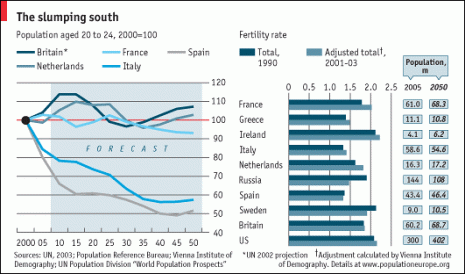The Economist on Europe's demography
The Economist has published an interesting piece on Europe’s demography. It indicates that Europe has pockets of relatively high (UK, France, Scandinavia) and very low fertility.
Chart and conclusions follow:
“None of this means that Europe has broken the chains of its demography. The EU’s overall population will fall by 7m by 2050. The so-called support ratio (roughly, the proportion of workers to pensioners) is declining everywhere. And as Mr Coleman points out, Europe’s share of global population will fall from 21% now to 7% by 2050. Even its successes are only relative. A fertility rate of 1.8 is still below replacement.
All the same, small shifts in fertility or the retirement age can go a long way to alleviating the burdens of population decline. Raising the retirement age by a year or two can make the difference between the solvency and insolvency of pensions. On current rates, Italy will have a mere 1.4 workers to support each retired person by 2050. France and Britain will have a much more favourable age pyramid, with more than two workers per pensioner.
All this is a world away from the other rich country with demographic growth: America. Much American debate focuses on the role of marriage and the traditional family in fostering a healthy society. In Europe, by contrast, only countries with many births outside wedlock and with high female participation rates have reasonably high birth rates. Those that have sought to maintain traditional family ties have seen fertility collapse.
Europeans are only starting the process of recovery. Compared with America, even the growing parts of the continent have modest fertility rates and high dependency ratios. But if Europe has a demographic future it lies in Britain, France and Scandinavia, not across the Atlantic.”
